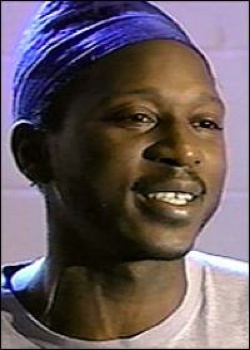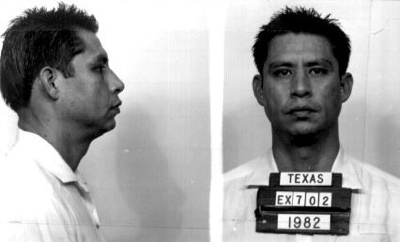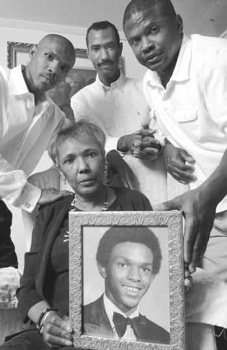 Music
Music  Music
Music  History
History 10 Less Than Jolly Events That Occurred on December 25
 Weird Stuff
Weird Stuff 10 Funny Ways That Researchers Overthink Christmas
 Politics
Politics 10 Political Scandals That Sent Crowds Into the Streets
 Weird Stuff
Weird Stuff Ten Bizarre Facts About The Doge Meme
 Our World
Our World 10 Ways Your Christmas Tree Is More Lit Than You Think
 Movies and TV
Movies and TV The 10 Coolest Stars to Set Sail on The Love Boat
 History
History 10 Things You Didn’t Know About the American National Anthem
 Technology
Technology Top 10 Everyday Tech Buzzwords That Hide a Darker Past
 Humans
Humans 10 Everyday Human Behaviors That Are Actually Survival Instincts
 Music
Music 10 Surprising Origin Stories of Your Favorite Holiday Songs
 History
History 10 Less Than Jolly Events That Occurred on December 25
 Weird Stuff
Weird Stuff 10 Funny Ways That Researchers Overthink Christmas
Who's Behind Listverse?

Jamie Frater
Head Editor
Jamie founded Listverse due to an insatiable desire to share fascinating, obscure, and bizarre facts. He has been a guest speaker on numerous national radio and television stations and is a five time published author.
More About Us Politics
Politics 10 Political Scandals That Sent Crowds Into the Streets
 Weird Stuff
Weird Stuff Ten Bizarre Facts About The Doge Meme
 Our World
Our World 10 Ways Your Christmas Tree Is More Lit Than You Think
 Movies and TV
Movies and TV The 10 Coolest Stars to Set Sail on The Love Boat
 History
History 10 Things You Didn’t Know About the American National Anthem
 Technology
Technology Top 10 Everyday Tech Buzzwords That Hide a Darker Past
 Humans
Humans 10 Everyday Human Behaviors That Are Actually Survival Instincts
10 Convicts Presumed Innocent After Execution
English jurist William Blackstone once said, “Better that ten guilty persons escape than that one innocent suffer.” Even lawyers are indoctrinated with this concept early in law school. Whether you support with the death penalty or not, most individuals would agree with the statement above. Despite the United State’s innocent-until-proven-guilty legal system, there are several cases where a presumably innocent person is convicted of a crime, some even put to death. Sadly, we may never get a chance to find out the truth. The recent inclusion of DNA evidence in trials has been used in some cases to clear many people falsely convicted. There are ten recent cases of people who are now presumed, but not proven, to be innocent and one bonus inclusion.
In February 1983, Wanda Lopez, was stabbed to death during her night shift at the gas station where she worked. After a brief manhunt, police found De Luna hiding under a pick-up truck. Recently released from prison, he was violating his parole by drinking in public. De Luna immediately told police that he was innocent and he offered the name of the person who he saw at the gas station. Police ignored the fact that he did not have a drop of blood on him even though the crime scene was covered in blood. De Luna was arrested too soon after the crime to clean himself up. The single eyewitness to the crime, Kevin Baker, confirmed to police that De Luna was the murderer after police told him he was the right guy.
At trial De Luna named Carlos Hernandez as the man he saw inside the gas station, across the street from the bar where De Luna had been drinking. Hernandez and DeLuna were strikingly similar in appearance but, unlike DeLuna, Hernandez had a long history of knife attacks similar to the convenience store killing and repeatedly told friends and relatives that he had committed the murder. Friends confirmed that he was romantically linked to Lopez as well. De Luna’s lawyers knew of Hernandez’s criminal past but never thoroughly investigated his previous crimes. On December 7, 1989, Texas executed 27-year old Carlos De Luna.
On June 26, 1980 in St. Louis, Missouri, 19-year-old Quintin Moss was killed in a drive-by shooting while allegedly dealing drugs on a street corner. The conviction was based largely on the testimony from Robert Fitzgerald, a white career criminal, who was at the scene at the time of the murder. He testified that he saw three black men in the car when shots were fired and that Griffin shot the victim through the window of the car with his right hand. This was Griffin’s attorney’s first murder trial and he did not challenge the testimony even though Griffin was left-handed. He also failed to bring forth an alibi witness who was with Griffin at the time of the murder.
Griffin’s fingerprints were not found on the car or the weapon – all evidence against him was circumstantial. There is evidence that suggests Fitzgerald was promised a reduce sentence in exchange for his testimony. The prosecution also failed to address that there were two other witnesses who confirmed that Griffin did not commit the murder and they were able to name the three men who did.Appeals courts upheld his conviction and death sentence. Griffin was executed by lethal injection on June 21, 1995. Griffin maintained his innocence right up to his execution. In 2005, a professor University of Michigan Law School reopened the case. His investigation concluded that Griffin was innocent.
On the night of November 8, 1984, Ruben Cantu and his friend David Garza, broke into a vacant San Antonio house under construction and robbed two men at gunpoint. The two victims, Pedro Gomez and Juan Moreno, had been workmen sleeping on floor mattresses at a construction site, guarding against burglary. As they tried to take their cash, they were interrupted by Gomez’s attempt to retrieve a pistol hidden under his mattress. The boys shot both men killing Gomez instantly. Thinking they had killed both men, the two teens then fled the scene.
The police showed Moreno photos of suspects, which included Cantu’s picture, and he was unable to identify his attacker. On the basis of no physical evidence, no confession, and only Moreno’s subsequently recanted testimony, a jury convicted Ruben Cantu of first-decree murder. Juan Moreno now says that he had felt pressure from the police to finger Cantu. David Garza, Cantu’s codefendant, has since admitted involvement in the burglary, assault and murder. He says he did go inside the house with another boy, did participate in the robbery, and saw the murder take place, but that his accomplice was not Ruben Cantu.On August 24, 1993, Ruben Cantu at the age of 26, was executed by lethal injection. His final request was for a piece of bubble gum, which was denied.
In 1982, David Spence was accused of the rape and murder of two 17-year-old girls and one 18-year-old boy in Waco, Texas. He received the death penalty in two trials for the murders. Muneer Deeb, a convenience store owner, hired Spence to do the murders and he was also charged and sentenced to death. He received a new trial in 1993 and was later acquitted.
The prosecution built its case against Spence around bite marks that a state expert said matched Spence’s teeth and jailhouse snitches. Two of the six jailhouse witnesses who testified at trial later recanted, saying they were given cigarettes, television and alcohol privileges, and conjugal visits for their testimonies. Spence’s post-conviction lawyers had a blind panel study in which five experts said the bite marks could not be matched to Spence’s. Even the original homicide investigator on the case said he had serious doubts about Spence’s guilt and a former Waco police detective involved in the case said he did not think Spence committed the crime. David Spence was executed by lethal injection on April 14, 1997.
On the morning of February 20, 1976, Highway Patrol officer, Phillip Black, and Donald Irwin, approached a car parked at a rest stop for a routine check. Tafero, his partner Sonia “Sunny” Jacobs, and Walter Rhodes were found asleep inside. Black saw a gun lying on the floor inside the car so he woke the occupants and had them come out of the car. According to Rhodes, Tafero then shot both Black and Irwin with the gun, which was illegally registered to Jacobs, led the others into the police car and fled the scene. All three were arrested after being caught in a roadblock. The gun was found in Tafero’s waistband.
At their trial, Rhodes testified that Tafero and Jacobs were solely responsible for the murders. Tafero and Jacobs were convicted of capital murder and sentenced to death while Rhodes was sentenced to 3 life sentences. Rhodes was eventually released in 1994 following parole for good behavior. Because the jury had recommended a life sentence for Jacobs, the court commuted Jacobs’ sentence to life in prison, but not Tafero’s. She was later released after agreeing to a plea bargain. Prior to his release, Rhodes confessed several times to lying about his involvement in the shooting. Even Sunny Jacobs claimed that Rhodes, not Tafero, carried out the shooting as well. Rhodes was the only person on which traces of gunpowder were found. Tafero was executed by electric chair on May 4, 1990. The chair malfunctioned causing the process to take over 13 minutes.
Ellis Wayne Felker was a suspect in the 1981 disappearance of a Georgia woman, Evelyn Joy Ludlum who was working her way through college as a cocktail waitress. He was put under police surveillance for 2 weeks, during which time Ludlum’s body was found in a creek, raped, stabbed and murdered. An autopsy performed by an untrained technician found that the body had been dead for five days. This information was later changed after realizing this would eliminate Felker as a suspect. Independent autopsies found that the body had been dead no more than three days.
In 1996, Felker’s attorneys discovered boxes of evidence that had been unlawfully withheld by the prosecution including DNA evidence and a written confession by another suspect. Even the presiding judge in one of Felker’s trials stated that his right to a fair trial had been severely compromised. Despite all this mounting evidence and doubts of his guilt, the Georgia Supreme Court denied Felker a new trial nor gave the defense more time to sort through the mounds of evidence to argue for exoneration. Felker was executed by electrocution November 15, 1996 at the age of 48. In 2000, a Georgia judge ruled that DNA testing would be performed in the first-ever attempt by a court to exonerate an executed person in the United States. The results were ruled as inconclusive.
On May 23, 1981 in Jacksonville, FL, police officer Thomas Szafranski killed when shots were fired at his police cruiser when he was stopped at an intersection. Within minutes, police officers busted into Leo Jones’ apartment where they found Jones and his cousin, Bobby Hammonds. Police took both men in for questioning and then charged Jones, who they claimed had confessed. Hammonds gave a statement, saying he saw Jones leave the apartment with a rifle and return after he heard some gunshots.In 1997, a retired police officer, Cleveland Smith, came forward and said the officer that arrested Jones had bragged that he beat Jones after his arrest. Smith, who described the officer as an “enforcer”, testified that he once watched him get a confession from a suspect through torture. Smith claimed that he waited so long to come forward with this evidence because he wanted to secure his pension.
More than a dozen people had implicated another man as the killer, saying they either saw him carrying a rifle as he ran from the crime scene or heard him brag he had shot the officer. Even Florida Supreme Court Justice Leander Shaw wrote that Jones’ case had become “a horse of a different color”. Newly discovered evidence, Shaw wrote, “casts serious doubt on Jones’ guilt.” Shaw and one other judge voted to grant Jones a new trial. However, a five-judge majority ruled against him. Jones was executed by electric chair on March 24, 1998.
In 1991, a fire occurred at Cameron Todd Willingham’s home in Texas killing his three young daughters. Willingham escaped the fire with minor injuries and his then-wife was not home at the time. Prosecutors charged Willingham with starting the fire in an attempt to cover up his abuse of his girls. This is despite the wife’s testimony that he had never abused the children and, in fact, “spoiled them rotten.” While laboratory tests verified that an accelerant was used only near the front porch, the prosecutors alleged that the fluid was deliberately poured near the front porch, children’s bedroom, and in the hallway to start the fire and impede rescue attempts. Gerald Hurst, who has a PhD in chemistry, reputed claims that the extreme heat of the fire meant that an accelerant was used. The Board of Pardons and Paroles received Hurst’s argument but still denied Willingham clemency.
Willingham was deemed an “extremely severe sociopath” by a psychiatrist using only Willingham’s Iron Maiden and Led Zeppelin posters as indications of his fascination with violence and death. Witness testimony during the fire was contradictory and inconclusive. During his trial in August 1992, Willingham was offered a life term in exchange for a guilty plea, which he turned down insisting he was innocent. Willingham was executed by lethal injection on February 17, 2004. In June 2009 the State of Texas ordered an unprecedented re-examination of the case and may issue a ruling on it at a later date.
In 1985, Helen Schartner was raped and murdered by strangulation outside a nightclub in Virginia Beach. At the time of the murder, O’Dell was already on parole for kidnapping and robbery convictions in Florida. O’Dell chose to represent himself during the trial and he was convicted of the murder in based solely on blood evidence and the testimony of a jailhouse “snitch.” There was nothing else linking O’Dell to the crime.
For much of the decade that followed, O’Dell’s unsuccessful appeals went to the Virginia Supreme Court, Federal District Court, and the Supreme Court, where Justice Harry Blackmun found “serious questions as to whether O’Dell committed the crime.” O’Dell’s lawyers also had an affidavit claiming that another inmate executed in 1993, David Mark Pruett, had confessed to the crime. O’Dell asked the state to conduct DNA tests on other pieces of evidence to demonstrate his innocence but was refused. An International campaign to save his life had supporters like Mother Teresa and Pope John Paul II. Both the governor of Virginia and the U.S. Supreme Court rejected last-minute pleas to spare his life and O’Dell was executed by lethal injection on July 23, 1997. In 2000, the last of the DNA evidence in the O’Dell case stored in the circuit court of Virginia Beach was burned without any further testing.
On September 29, 1981, Texas Department of Public Safety Officer, David Rucker, was shot and killed along a stretch of highway near the Rio Grande Valley. Around the same time, police officer Enrique Carrisalez pulled over a speeding vehicle driving away from the road where Rucker’s body was found. The driver exchanged words with Carrisalez before pulling out his gun and killing the police officer. Lionel Herrera was arrested a few days later and charged with both Rucker’s and Carrisalez’s murders. Before he died, Carrisalez also identified Herrera as the person who shot him from a single photograph shown to him in the hospital (not a photo array). In January 1982, Herrera was tried and found guilty of the capital murder of Carrisalez, for which he was sentenced to death. Later that year, Herrera pleaded guilty to the murder of Rucker.
Herrera filed a petition for writ of habeas corpus in federal court, claiming that new evidence demonstrated he was actually innocent of the murder of Carrisalez. Herrera included four affidavits from an attorney who had represented Herrera’s brother, Raul Herrera, Sr, and three others claiming that Raul Herrera, who was murdered in 1984, had told them that he had killed Rucker and Carrisalez. This lead to the Supreme Court case Herrera v. Collins where the Court ruled that new evidence demonstrating innocence did not violate the Constitution’s 8th Amendment and Herrera’s death sentence with upheld. Herrera was executed by lethal injection four months after the ruling. In his final statement he said: “I am innocent, innocent, innocent. . . . I am an innocent man, and something very wrong is taking place tonight.”
In 1985, Texas Tech student Michele Mallin was raped and Timothy Cole was sentenced to 25 years in prison just based on her testimony. He was offered parole if he would admit guilt, but he refused. Later, Mallin admitted she was mistaken with the identity of her attacked and in 1995, Jerry Wayne Johnson confessed to the rape. She stated that investigators botched the gathering of evidence and withheld information from her, causing her to believe that Cole was the attacker. Mallin told police that her rapist smoked during the rape. However, Cole never smoked because he had severe asthma.
When DNA evidence showed him to be innocent, he was exonerated on February 6, 2009. Cole died, however, in prison on December 2, 1999 from an asthma attack. It was the first posthumous DNA exoneration in the state of Texas.



















